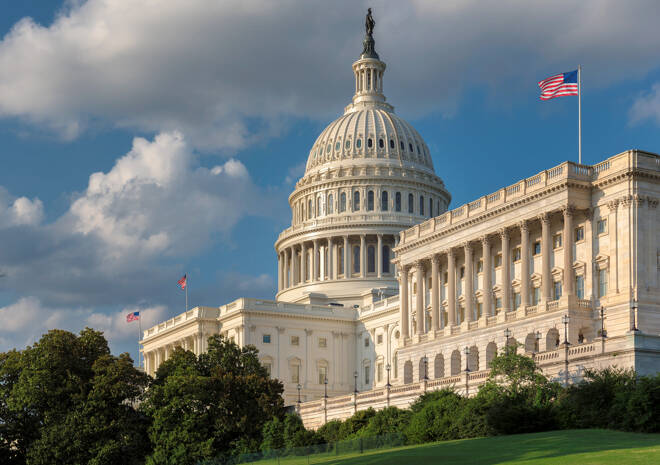Advertisement
Advertisement
Lummis and Gillibrand Bill Aims to Give Crypto Oversight to the CFTC
By:
A new crypto bill begins its passage on Capitol Hill that could hand the oversight of digital assets to the CFTC. It may be too late for XRP, however.
Key Insights:
- Cynthia Lummis and Kirsten Gillibrand filed the Responsible Financial Innovation Act, which would give digital asset oversight powers to the Commodity Futures Trading Commission (CFTC).
- The crypto market showed little reaction, with the bill in its early stages of passage.
- Any final approval of the bill may come too late for Ripple Labs, currently embroiled in a lengthy legal battle with the Securities and Exchange Commission (SEC).
Regulatory chatter spiked in recent weeks, with the collapse of TerraUSD (UST) and Terra LUNA incentivizing governments and regulators to expedite new crypto regulations. Both the CFTC and the SEC have been vocal, as the SEC v Ripple (XRP) case drags on.
For some jurisdictions, began work on introducing a more robust crypto regulatory framework sooner than in others.
In the US, the Biden Administration put cryptos front and center with the release of the White House Executive Order in March.
While the Executive Order was silent on which authority should regulate the crypto sector, the administration identified the need for lawmakers to deliver a regulatory framework.
This week, senators from both sides of the aisle introduced a bill looking to address the very issues that the crypto industry faces within the US.
Lummis and Gillibrand Deliver a Bipartisan Bill to Regulate Cryptos
In March, Democrat Kirsten Gillibrand announced that lawmakers are working on a “broad-based regulatory framework for how this industry should potentially be regulated in the future.”
At that time, Gillibrand reportedly said,
“Some parts will be regulated by the Commodity Futures Trading Commission, some parts will be regulated under the Securities and Exchange Commission.”
This week, news hit the wires of US lawmakers aiming to put the oversight of cryptos and other digital assets into the hands of the CFTC.
US senators Cynthia Lummis and Kirsten Gillibrand filed the Responsible Financial Innovation Act. The bill would give digital asset oversight powers to the CFTC.
While crypto companies side with the CFTC, lawmakers remain undecided. Indecision leaves the digital asset space in a regulatory black hole.
For the digital asset space that encompasses crypto and NFTs, a resolution to the classification of cryptos and NFTs would be a step in the right direction.
At present, the Securities and Exchange Commission is embroiled in a lengthy legal battle with Ripple Labs over the sale of XRP, claiming that XRP are securities and not commodities.
For Ripple Lab and XRP, the passing of a bill may come too late. It remains to be seen, however, whether the outcome of the SEC v Ripple case has any influence.
A Ripple victory, either by way of settlement or in court, would put the CFTC on a stronger footing.
Regulatory uncertainty continues to weigh on the crypto market. Progress towards handing the reins to the CFTC should be crypto market positive.
The crypto majors have shown little reaction, however, with the bill in its early stage of passage.
XRP Price Action
At the time of writing, XRP was down 0.32% to $0.3988.
A mixed morning saw XRP rise to an early high of $0.4014 before falling to a low of $0.3968.
Technical Indicators
XRP will need to move through the $0.4016 pivot to target the First Major Resistance Level at $0.4084. XRP would need the broader crypto market to support a return to $0.40.
In a broad-based crypto rebound, XRP should test the Second Major Resistance Level at $0.4168 and resistance at $0.42.
Failure to move through the pivot would bring the First Major Support Level at $0.3932 into play.
Barring an extended sell-off throughout the day, XRP should avoid the Second Major Support Level at $0.3864.
The EMAs and the 4-hourly candlestick chart (below) send a bearish signal. At the time of writing, XRP sits below the 50-day EMA, currently at $0.3990. Today, the 50-day EMA flattened on the 100-day EMA. The 100-day EMA fell back from the 200-day EMA, XRP negative.
A move through the 100-day EMA, currently at $0.4072, would support a run at the 200-day EMA and $0.45. For XRP, however, a breakout may be unlikely ahead of any court ruling on the Hinman documents following Tuesday’s conference.
About the Author
Bob Masonauthor
With over 28 years of experience in the financial industry, Bob has worked with various global rating agencies and multinational banks. Currently he is covering currencies, commodities, alternative asset classes and global equities, focusing mostly on European and Asian markets.
Did you find this article useful?
Latest news and analysis
Advertisement
